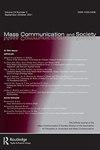另一个观点:对第三人称研究现状的学术回应
IF 2.7
2区 文学
Q1 COMMUNICATION
引用次数: 0
摘要
在一系列的文章中,学者们对Perloff和Shen的文章《戴维森写作40年后的第三人称效应》做出了回应。他们对如何衡量这种现象、未来研究的方向、甚至这种影响是否真实提供了进一步的思考。本文章由计算机程序翻译,如有差异,请以英文原文为准。
Another Point of View: Scholarly Responses to the State of Third-Person Research
ABSTRACT In a series of essays, scholars respond to Perloff and Shen’s article, “The Third-Person Effect 40 Years After Davison Penned It.” They offer further thoughts on how to measure the phenomenon, where future research is headed, and even whether the effect is real.
求助全文
通过发布文献求助,成功后即可免费获取论文全文。
去求助
来源期刊

Mass Communication and Society
COMMUNICATION-
CiteScore
6.90
自引率
3.30%
发文量
58
期刊介绍:
Mass Communication and Society" mission is to publish articles from a wide variety of perspectives and approaches that advance mass communication theory, especially at the societal or macrosocial level. It draws heavily from many other disciplines, including sociology, psychology, anthropology, philosophy, law, and history. Methodologically, journal articles employ qualitative and quantitative methods, survey research, ethnography, laboratory experiments, historical methods, and legal analysis.
 求助内容:
求助内容: 应助结果提醒方式:
应助结果提醒方式:


